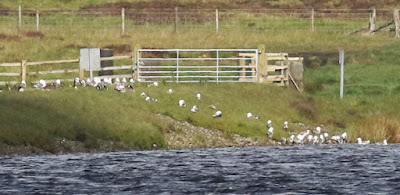2 Wheatear present
Several Swifts in the mist
Unusual count of LBBs NW bank.
1 pr Ringed Plover present
Another of Fly Flatts speciality weather fronts to start the morning with rain and drizzle on a moderate NW>4 at 9 degrees but good visibility. By 0930 hrs the clouds cleared leaving it dry with a bit of blue sky and sunshine.
Another surprise on route this morning when a Cuckoo flew low across the front of the car then dipped over the Nolstar field, disappearing into Slaughter Gap.
A second surprise was to see 68 big gulls on the NW corner banking, the majority being LBBs but too distant to check through them, even through the scope.
Two Wheatear were present, after an exceptionally poor spring with this species being well down in numbers, possibly due to all the bad weather.
Lots of Swallows and Swifts over when the cloud base was low but disappeared once the sky cleared, possibly going over very high.
A few waders still hanging on, despite the loss of shore, with 1 pair Ringed Plover, 3 Common Sandpiper, 1 Oystercatcher and a single Redshank, along with the Lapwings and Curlews.
Otherwise, a single Kestrel plus the usual Mipits etc.
Come June, the next expected waders are Dunlin, which usually peak in June, and Sanderling, which can be very hit and miss. These two species depend on some shore being exposed but failing that, June is always good to produce a Common Scoter or two to fall back on.
Possibly a few dry days now with decent visibility with a moderate NNW for morning and a cloudy day.
BS











